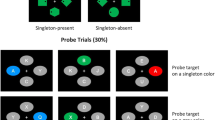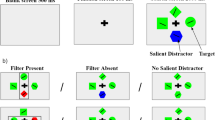Abstract
A recent paper has reported, for the first time, that people are capable of suppressing salient singleton distractors of unknown color if the search task requires them to search for the most prevalent of several shapes in the display. We identify here several potential limitations of the earlier findings. In particular, in the reported experiments, the likelihood of a salient distractor was higher than what is typically studied, the distractor object was similar in shape to the relevant objects, only two colors were studied, the distractor was consistently a fixed shape, and the distractor was always a unique shape different from the search targets. Each of these limitations leaves open some questions about the generality of the findings. We address each of the concerns here, and show, in five experiments, that the ability to suppress distractors of unknown color is a robust finding that is not compromised by the potential limitations identified. When searching for the most prevalent of several shapes in a display, people can indeed suppress capture by otherwise-salient color singleton distractors even when their color is not known in advance (i.e., in a feature-blind manner), facilitating efficient search. The experiments confirm the ability to suppress visual elements based on second-order (e.g., a unique color) or global salience information, and not merely based on first-order (e.g., a specific color) information.











Similar content being viewed by others
References
Bacon, W. F., & Egeth, H. E. (1994). Overriding stimulus-driven attentional capture. Perception & Psychophysics, 55(5), 485–496. https://doi.org/10.3758/BF03205306
Burra, N., & Kerzel, D. (2013). Attentional capture during visual search is attenuated by target predictability: Evidence from the N2pc, Pd, and topographic segmentation. Psychophysiology, 50(5), 422–430. https://doi.org/10.1111/PSYP.12019
Chang, S., & Egeth, H. E. (2019). Enhancement and suppression flexibly guide attention. Psychological Science, 30(12), 1724–1732. https://doi.org/10.1177/0956797619878813
Chang, S., & Egeth, H. E. (2021). Can salient stimuli really be suppressed? Attention, Perception, and Psychophysics, 83(1), 260–269. https://doi.org/10.3758/S13414-020-02207-8
Cousineau, D., Goulet, M. A., & Harding, B. (2021). Summary plots with adjusted error bars: The superb framework with an implementation in R: Advances in methods and practices. Psychological Science, 4(3). https://doi.org/10.1177/25152459211035109
Erdfelder, E., Faul, F., & Buchner, A. (1996). GPOWER: A general power analysis program. Behavior Research Methods, Instruments, & Computers, 28(1), 1–11. https://doi.org/10.3758/BF03203630
Folk, C. L., Remington, R. W., & Johnston, J. C. (1992). Involuntary covert orienting is contingent on attentional control settings. Journal of Experimental Psychology: Human Perception and Performance, 18(4), 1030–1044. https://doi.org/10.1037/0096-1523.18.4.1030
Gaspelin, N., Egeth, H. E., & Luck, S. J. (2023). A critique of the attentional window account of capture failures. Journal of. Cognition.
Gaspelin, N., Leonard, C. J., & Luck, S. J. (2015). Direct evidence for active suppression of salient-but-irrelevant sensory inputs. Psychological Science, 26(11), 1740–1750. https://doi.org/10.1177/0956797615597913
Gaspelin, N., Leonard, C. J., & Luck, S. J. (2017). Suppression of overt attentional capture by salient-but-irrelevant color singletons. Attention, Perception, and Psychophysics, 79(1), 45–62. https://doi.org/10.3758/S13414-016-1209-1
Gaspelin, N., & Luck, S. J. (2018a). The role of inhibition in avoiding distraction by salient stimuli. Trends in Cognitive Sciences, 22(1), 79–92. https://doi.org/10.1016/J.TICS.2017.11.001
Gaspelin, N., & Luck, S. J. (2018b). Distinguishing among potential mechanisms of singleton suppression. Journal of Experimental Psychology: Human Perception and Performance, 44(4), 626–644. https://doi.org/10.1037/XHP0000484
Geyer, T., Müller, H. J., & Krummenacher, J. (2008). Expectancies modulate attentional capture by salient color singletons. Vision Research, 48(11), 1315–1326. https://doi.org/10.1016/J.VISRES.2008.02.006
Huang, C., Donk, M., & Theeuwes, J. (2022). Proactive enhancement and suppression elicited by statistical regularities in visual search. Journal of Experimental Psychology: Human Perception and Performance, 48(5), 443–457. https://doi.org/10.1037/XHP0001002
Kim, H., Ogden, A., & Anderson, B. A. (2023). Statistical learning of distractor shape modulates attentional capture. Vision Research, 202, 108155. https://doi.org/10.1016/J.VISRES.2022.108155
Leber, A. B., & Egeth, H. E. (2006). It’s under control: Top-down search strategies can override attentional capture. Psychonomic Bulletin & Review, 13(1), 132–138. https://doi.org/10.3758/BF03193824
Leber, A. B., Gwinn, R. E., Hong, Y., & O’Toole, R. J. (2016). Implicitly learned suppression of irrelevant spatial locations. Psychonomic Bulletin and Review, 23(6), 1873–1881. https://doi.org/10.3758/S13423-016-1065-Y
Luck, S. J., Gaspelin, N., Folk, C. L., Remington, R. W., & Theeuwes, J. (2020). Progress toward resolving the attentional capture debate. Visual Cognition, 29(1), 1–21. https://doi.org/10.1080/13506285.2020.1848949
Ma, X., & Abrams, R. A. (2022). Ignoring the unknown: Attentional suppression of unpredictable visual distraction. Journal of Experimental Psychology: Human Perception and Performance, 49(1), 1–6. https://doi.org/10.1037/XHP0001067
Munneke, J., van der Stigchel, S., & Theeuwes, J. (2008). Cueing the location of a distractor: An inhibitory mechanism of spatial attention? Acta Psychologica, 129(1), 101–107. https://doi.org/10.1016/J.ACTPSY.2008.05.004
Navarro, D. (2015). Learning statistics with R: A tutorial for psychology students and other beginners. (Version 0.6). University of New South Wales. https://learningstatisticswithr.com
Oxner, M., Martinovic, J., Forschack, N., Lempe, R., Gundlach, C., & Müller, M. (2022). Global enhancement of target color-not proactive suppression-explains attentional deployment during visual search. Journal of Experimental Psychology: General. Advance online publication. https://doi.org/10.1037/xge0001350
Pashler, H. (1988). Cross-dimensional interaction and texture segregation. Perception & Psychophysics, 43(4), 307–318. https://doi.org/10.3758/BF03208800
Peirce, J. W., Hirst, R. J., & MacAskill, M. R. (2022). Building Experiments in PsychoPy (2nd ed.). SAGE Publications.
R Core Team. (2020). R: A language and environment for statistical computing. R Foundation for Statistical Computing. https://www.R-project.org/
Sawaki, R., & Luck, S. J. (2010). Capture versus suppression of attention by salient singletons: Electrophysiological evidence for an automatic attend-to-me signal. Attention, Perception, & Psychophysics, 72(6), 1455–1470. https://doi.org/10.3758/APP.72.6.1455
Stilwell, B. T., Bahle, B., & Vecera, S. P. (2019). Feature-based statistical regularities of distractors modulate attentional capture. Journal of Experimental Psychology: Human Perception and Performance, 45(3), 419–433. https://doi.org/10.1037/XHP0000613
Stilwell, B. T., Egeth, H., & Gaspelin, N. (2022). Electrophysiological evidence for the suppression of highly salient distractors. Journal of Cognitive Neuroscience, 34(5), 787–805. https://doi.org/10.1162/JOCN_A_01827
Stilwell, B. T., & Gaspelin, N. (2021). Attentional suppression of highly salient color singletons. Journal of Experimental Psychology: Human Perception and Performance, 47(10), 1313–1328. https://doi.org/10.1037/XHP0000948
Theeuwes, J. (1992). Perceptual selectivity for color and form. Perception & Psychophysics, 51(6), 599–606. https://doi.org/10.3758/BF03211656
Theeuwes, J. (2004). Top-down search strategies cannot override attentional capture. Psychonomic Bulletin & Review, 11(1), 65–70. https://doi.org/10.3758/BF03206462
Theeuwes, J. (2023). The attentional capture debate: When can we avoid salient distractors and when not? Journal of Cognition. https://doi.org/10.5334/joc.251
Vatterott, D. B., Mozer, M. C., & Vecera, S. P. (2018). Rejecting salient distractors: Generalization from experience. Attention, Perception, & Psychophysics, 80(2), 485–499. https://doi.org/10.3758/S13414-017-1465-8/FIGURES/5
Wang, B., & Theeuwes, J. (2018a). Statistical regularities modulate attentional capture. Journal of Experimental Psychology. Human Perception and Performance, 44(1), 13–17. https://doi.org/10.1037/XHP0000472
Wang, B., & Theeuwes, J. (2018b). How to inhibit a distractor location? Statistical learning versus active, top-down suppression. Attention, Perception, & Psychophysics, 80(4), 860–870. https://doi.org/10.3758/S13414-018-1493-Z
Wolfe, J. M. (2021). Guided search 6.0: An updated model of visual search. Psychonomic Bulletin & Review, 1–33Advance online publication. https://doi.org/10.3758/S13423-020-01859-9
Won, B. Y., Kosoyan, M., & Geng, J. J. (2019). Evidence for second-order singleton suppression based on probabilistic expectations. Journal of Experimental Psychology: Human Perception and Performance, 45(1), 125–138. https://doi.org/10.1037/XHP0000594
Wöstmann, M., Störmer, V. S., Obleser, J., Addleman, D. A., Andersen, Søren K., Gaspelin, N., Geng, J. J., Luck, S. J., Noonan, M. A. P., Slagter, H. A., & Theeuwes, J. (2022).Ten simple rules to study distractor suppression. Progress in Neurobiology, 213,Article 102269.https://doi.org/10.1016/J.PNEUROBIO.2022.102269
Author information
Authors and Affiliations
Corresponding author
Additional information
The data and materials for all experiments are available online https://osf.io/f235r/. None of the experiments was preregistered.
Publisher’s note
Springer Nature remains neutral with regard to jurisdictional claims in published maps and institutional affiliations.
Statement of significance
Efficient visual processing requires selection of the parts of a scene that are relevant to the observer’s goal, and the avoidance of salient-but-irrelevant distractors in the scene. The ability to suppress attentional capture by otherwise-salient distractors has been believed to require that the distractor be a known color--until a recent paper demonstrated the possibility of suppressing color-unpredictable distractors. The present study extends that recent finding in five important ways by addressing, and dismissing, potential limitations in the previous experiments.
Rights and permissions
Springer Nature or its licensor (e.g. a society or other partner) holds exclusive rights to this article under a publishing agreement with the author(s) or other rightsholder(s); author self-archiving of the accepted manuscript version of this article is solely governed by the terms of such publishing agreement and applicable law.
About this article
Cite this article
Ma, X., Abrams, R.A. Feature-blind attentional suppression of salient distractors. Atten Percept Psychophys 85, 1409–1424 (2023). https://doi.org/10.3758/s13414-023-02712-6
Accepted:
Published:
Issue Date:
DOI: https://doi.org/10.3758/s13414-023-02712-6




